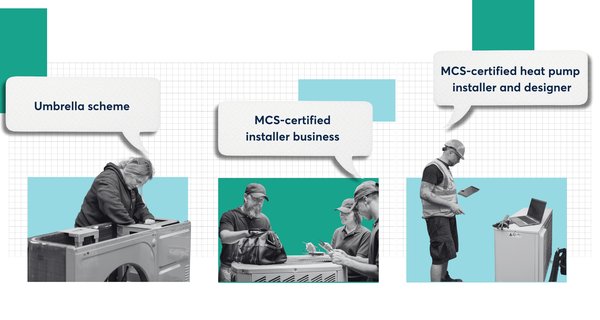The scheme is looked on favourably by larger businesses but can be difficult for smaller installers. The documentation that surrounds LCH installs can cause friction for smaller installation companies. The accreditation process that provides access to the existing scheme may be adding friction and preventing some installers from registering for the scheme.
- While the current documentation and standards may be causing tension, all parties agree ensuring performance and consumer protection is important.
- There is a discrepancy between the standards expected of low-carbon heating and fossil fuel systems that could be contributing to the price differentiation and consumer journey issues.
What we've heard
The advantage of greater cash flow and access to finance inherent in larger heating businesses and SMEs is exacerbated under BUS’s ‘rebate’ delivery method, its subsidy structure, and its restrictions (technology, system and quality assurance requirements), which – alongside electricity prices – push projects for low-carbon heating installations toward higher ratios of equipment to labour costs. This may be limiting the volume of work possible by smaller businesses and sole traders, as several industry stakeholders have expressed, and discouraging some households from accessing the grant. And although MCS (the current quality assurance provider) has recently committed to redeveloping their scheme which has addressed several concerns, there is still further opportunity to reduce the barriers to access for sole traders and small businesses.
Our recent research, consisting of workshops with industry and semi-structured interviews with households consistently emphasised certain barriers. One noteworthy obstacle that may have been exacerbated by the increase of BUS to £7500, is the heightened concern among businesses about potential cash flow limitations. This is particularly relevant for sole traders.
“Turn-around time of payments – £7500 is a large portion of cash flow for a sole trader.”
Additionally, there is a notable issue of households misunderstanding the grant structure, contributing to these barriers. BUS funding was stated to be an ‘upfront capital grant’ however, in practice, it’s a ‘rebate’ to the installer with a 2-week delay. The advantage of greater cash flow and access to finance inherent in larger heating businesses and SMEs is exacerbated under this ‘rebate’ delivery method. This may be limiting the volume of work possible by smaller businesses and sole traders, as several industry stakeholders have expressed, discouraging some households from accessing the grant.
Overall the general administration of the scheme was looked on positively. Although there were differing opinions on whether a subsidy should be installer or consumer-led, the recurring theme was that the current BUS scheme is easier for larger companies to manage.
“Any grant should go to the customer, not the installer. Installers should not be middlemen… it increases the cost of the install, puts admin burden on the installer… the actual process is okay, once you get approved… all online, very simple process, 14-day turnaround on grants, works quite well… it's just, you shouldn't need the process, could all just be an app that the government centralises – upload pictures of install and any paperwork, customer signs on app and it automatically pulls up the appropriate heat pump manual.”
"(A subsidy) should be customer-led, not installer-led. It is, in the main, simple to deliver, but where Ofgem require more information the installer is piggy in the middle and it adds to the burden. You also hinder the amount of installs smaller/sole traders can do because of the impact on cash flow. They will not commit to more BUS jobs if they then are waiting for more and more £5ks. "
“The BUS is working extremely well, compared to other schemes of the past. Applications volumes were low initially as installers got used to the scheme but have jumped up 170% since the grant increased.”
“[Installer-led] is likely better, or at least have it as an option… installers will have done it several times compared to one-off for households… we need to simplify things [for households] especially for the elderly, many not comfortable online… [households] are not being educated enough by HES (consumer-led) anyways… either provide enough education or leave it to installers.”
Alongside the difficulties in managing cash flow around the grant, there may be barriers presented for existing engineers becoming eligible to access subsidy funds. For existing heating engineers, becoming a fully-qualified MCS Technical Supervisor for the air-source heat pump technology category requires a training course and/or assessment costing £600-£1,000 and requiring a few days, but 1-3 month wait times for an assessment are possible. For those starting with no qualifications and no significant previous heating or plumbing experience (less than a year full-time), this may take 1-3 years and £3,000-£6,000 (depending on course selection & availability).
“It may not seem like a lot of money to some people but for an individual contractor to be able to install heat pumps [for typical homes] themselves, it takes about £6K just to join, and then having someone come and tell me what to do and how to do it [regardless of my experience], plus hiring someone full time for the paperwork… makes it very difficult.”
Eligibility requirements to participate in the subsidy schemes (BUS, HES, ECO), specifically some of the steps to become MCS certified, favour larger companies.
“Larger companies are monopolising the [BUS and HES] grants due to the current accreditation requirements, 1-2 man-bands can’t achieve it.”
Several experienced low-carbon heating installers were previously not being sufficiently supported to become certified. These installers commonly stated the following barriers:
- Requiring several clarifications to understand the design and business standards.
- The increased compliance considerations and paperwork are unmanageable for a small business or sole trader.
- The ‘first install’ dilemma. In order to become MCS accredited an install has to be completed, this customer cannot take advantage of the BUS scheme.
MCS has broadly addressed the ‘first install’ problem within their proposal to enable ‘simulated’ assessments. However, on the difficulties faced by SMEs around installation documentation and paperwork, frustrations may be compounded by the quality of installs. The procedures and paperwork required still appear greater than installers think is necessary for quality assurance.
“I can give you a SCOP rating, but then I leave the house and you change all the settings. As soon as I leave the house the paperwork becomes nonsense. All you need is the quote, heat loss, and a commissioning sheet.”
“Poor quality installations are even present within pilot schemes with several designers and lots of resources. I have corrected a few of these installations.”
A lack of trust in the existing scheme to maintain standards and offer consumer protection may compound concerns around joining accreditation schemes that in turn give access to the subsidy. The extent to which MCS has helped enable consumer protection and redress against installer non-compliance to their technology standards has been less than ideal as recognised by their own research (2022) Of the HP survey respondents from MCS research in 2022, 18% were dissatisfied with installation or performance and 16% made a claim on insurance against workmanship. We heard that installs should be monitored and there should be consumer protection, however, there may be ways to ensure this is done in a manner that works better for engineers and consumers.
“I would like to see a scheme a bit like MCS, but with more oomph to it, [regarding the auditing and consumer protection]. Either systems’ designers or a central body should have to verify the end result with detailed pictures from installers or more randomised audits to be conducted.”
“It took 2 years to go through the consumer protection of the grant to get the same MCS installer to come back, upgrade two radiators, and enable Weather Compensation for the system. It was the Furniture & Home Improvement Ombudsman who resolved the issue.”
MCS’s recent consultation recognises this and MCS has recently committed to redeveloping their scheme with new rules in an attempt to help enable more businesses to engage with the BUS scheme and to increase the consistency of high-quality outcomes for consumers. MCS has also started a new policy of contacting each homeowner following a BUS installation.
What barriers do we need to overcome?
For industry
- The resource required to complete compliance documentation is still seen as a barrier to sole traders and microbusinesses.
- A perceived concern around cash flow. This may be an area of the business that some engineers may not have the same level of experience in.
For policymakers and scheme administrators
- Current quality assurance mechanisms may not be encouraging the uptake of BUS from households nor ensuring consistent installation, performance, or redress experiences for consumers.
- Consumers may have greater trust in schemes run directly by the government rather than simply endorsed by the government.
Concepts/recommendations
What if...
- The administrative burden required in the commissioning of a system was reduced? What would be the right balance of consumer protection, quality assurance and subsidy governance?
How a subsidy scheme could simplify consumer protection
- Other measures of quality were considered – either by MCS or pulled in-house by the subsidy scheme?
- Could a digital service reduce the burden of relevant checks?
- Could heating installations be monitored remotely to ensure quality?
- There were different mechanisms of delivery dependent on the size of the installer business?
- We knew what combination of accreditation may enable more engineers to access schemes, while still providing consumer protection? Could this unlock more technology types or other parts of the heating workforce?






